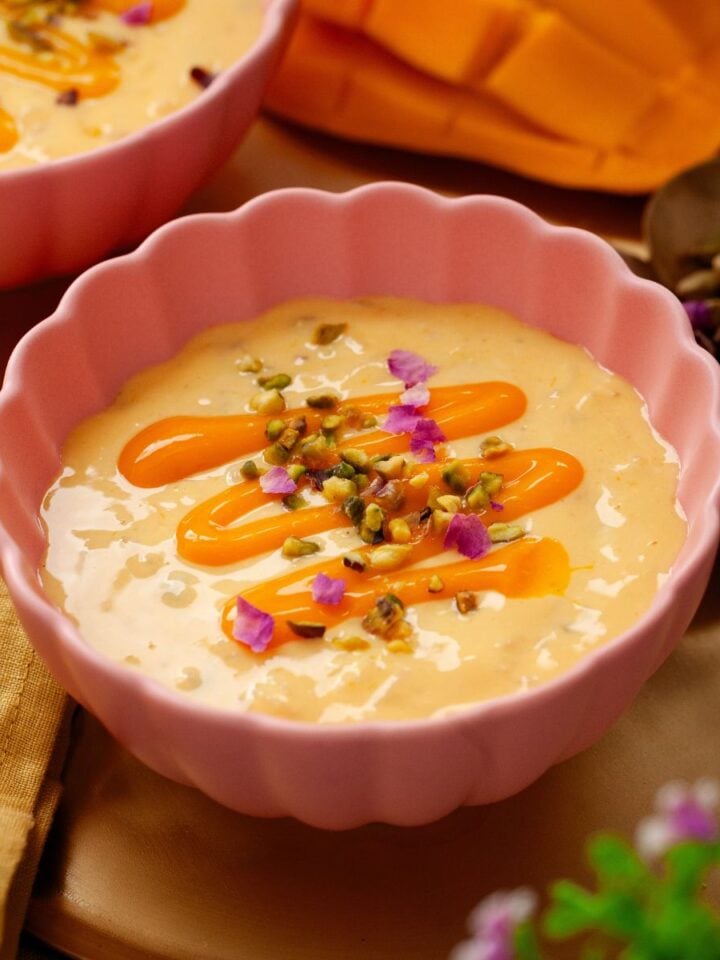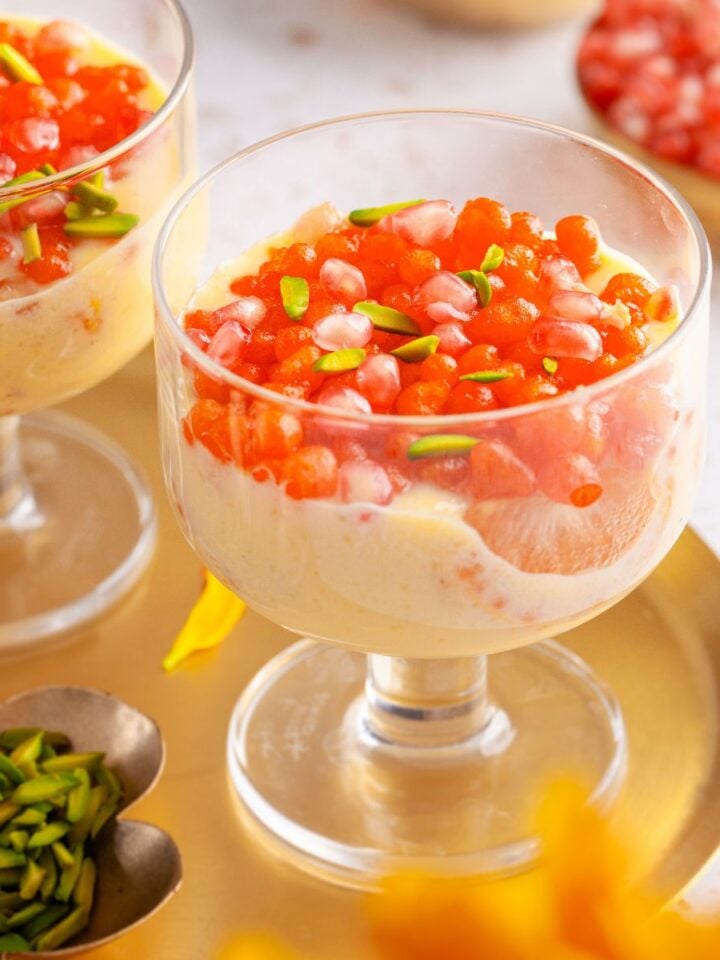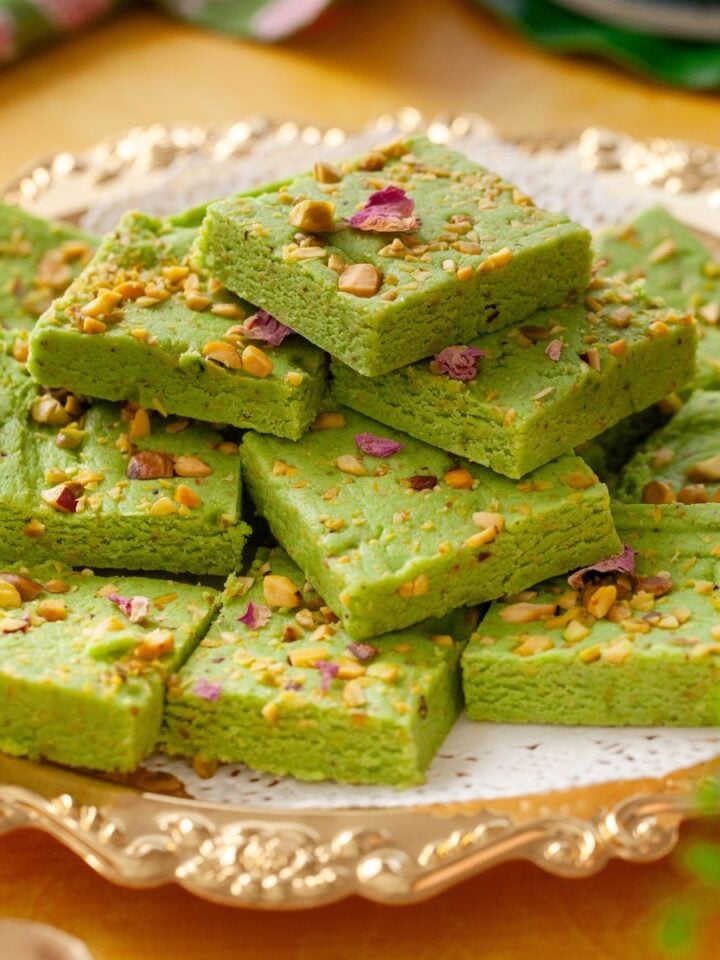In this post, I’ll show you how to make soft, melt-in-your-mouth suji halwa with a beautifully unique caramelized color. Also known as sooji ka halwa or sheera, this easy recipe comes straight from my grandmother and uses just a handful of simple ingredients like semolina, sugar, ghee, and water. Takes 20-25 minutes!

In north Indian homes, suji halwa is cooked in a blink to translate any occasion - big or little into a celebration. It is a simple, soul warming traditional indian dessert. We make it on festivals and special occasions. In our home, we love it for sunday breakfast with aloo poori. During Navratri, it is served with dry kala chana and poori for ashtami prasad.
About My Heirloom Recipe
You will find many ways of making sooji ka halwa all over India. Largely, the basic recipe remains the same. I first shared an image of this suji halwa on my Instagram page back in 2017 and ever since I have been asked multiple times how I get this unique color. It's how my grandmother taught me and here's how I remember her sooji halwa recipe:-
- I ’ve always known a bowl of sooji halwa for its deep brown hue and beautifully glistening with ghee. Whenever I see it, I’m instantly nostalgic of the aroma that use to fill the air of the house as my grandmother patiently fried the semolina in ghee for what felt like forever. And that’s the secret — the eye catching color develops when you roast the suji low and slow, stirring it continuously to perfection. A lot of elbow grease comes in handy but its all worth it!
- Most people flavor suji halwa with green cardamom, but in our home, it is always the freshly pounded powder from black cardamom seeds. Black cardamom has a bold, woody aroma—a flavor you wouldn’t typically associate with delicate Indian sweets or desserts, but it adds a surprising depth of flavor that beautifully complements the richness of the ghee and the roasted semolina.
- A lot of recipes add milk but my gradmother used sugar syrup. There is no need to check thread consistency of syrup. You will also cook the golden suji with sugar syrup low and slow until the ghee starts seperating - one of the key steps in which halwa acquires the "bhuna" or shiny look and little caramelization of sugar happens which contributes to the color.

Ingredients
- Suji (Semolina) - For a melt in mouth, soft halwa that delivers a delicate mithai like mouth feel, choose fine semolina. The semolina packets you get in indian grocery stores mention it if semolina is fine or coarse. If you like your halwa to be a bit chewy, use regular coarse semolina. This recipe will work with either. I use fine suji.
- Ghee - A must! Indian sweets are unimaginable without the rich & nutty aroma of ghee.
- Water - I use water, to keep the dark amber color. If you wish, milk can be used but keep in mind that milk will make the halwa a bit sticky as well as the color won't be deep brown.
- White Granulated Sugar - Traditionally sugar is used. You could use jaggery(use chopped), cane sugar or raw sugar. Don't use milk if you are using jaggery else milk might curdle.
- Nuts & Flavors- Anyting you like! I always use golden raisins because that's what what my grandmother always added to halwa . You can add cashews, makhana or shredded coconut as well. For flavoring you can use rose water, green cardamom powder or saffron strands.

How To Make Suji Halwa (Step By Step Pictures)
- Open up the black cardamom pods and add the seeds to a mortar. Pound the seeds to as fine powder as you can. Keep near.
- Place a large heavy bottom pan (like cast iron pan) or kadhai on stove on low flame. Add the ghee and let melt. For the entire length of the recipe, we are going to keep stove on low flame.
- Add the suji to the ghee and using a spatula, mix well for a minute or so until you see all the semolina granules are covered in ghee.



- Begin roasting the semolina in ghee. Keep an eye and keep stirring continually as fine semolina tends to burn easily. You will see that as you stir, the suji starts feels fluffy under the spatula.
- While the semolina is roasting, add the sugar and water to a small sauce pot and place on the other stove on low medium heat. In about 3-5 minutes, as the water comes to a boil, the sugar will dissolve. Switch off the stove, don't cook the syrup. We don‘t want any string consistency. Add the black cardamom seeds powder to the syrup. Keep the syrup warm.
- Coming back to semolina, keep on roasting it while making sure to scrape it from the sides of the pan. Roast the semolina for good 10- 12 minutes or until you see that the ghee begins to separate and the semolina granules are deep brown in color. There should be no black specks of semolina- that means the semolina has burnt, that’s why we need consistent low flame and continual stirring to ensure that won't happen.



- To the roasted suji, carefully and slowly add the warm sugar syrup (there will be spluttering). Make sure that you are stirring the suji at the same time to make sure that no lumps are formed.
- As soon as the syrup is added, you will see that halwa turns into a bubbly puddle like consistency. Keep stirring and continue to cook on low heat.
- Cook the halwa for 3-5 minutes. Let most of the liquid absorb. Slowly it will become soft pudding like consistency and you will be able to fold it over itself. You will see it getting shiny. The more you cook, the more ghee seperation occurs. If you want, add 1-2 tablespoon more ghee at this point for added richness. The halwa will thicken further as it rests.
- Serve warm garnished with nuts. Enjoy!



Recipe Tips
- Cook the halwa on low heat. Continuous stirring helps in evenly roasting semolina. Stirring gently yet continuously after adding syrup makes for a creamier halwa.
- Amount of ghee can be varied but please keep in mind that skimping on ghee will affect the proper texture of halwa and it will taste dry.
- You can reduce the amount of sugar if desired.
- If you don't want a dark halwa- roast the semolina in ghee for just 5-7 minutes, until its pinkish golden in color. Rest of the recipe remains the same.
- If you like a runny halwa, increase the water quantity to 3.5 cup.
- Store halwa in air tight container for 4-5 days refrigerated. Reheat when serving.
- Suji halwa freezes beautifully too. Freeze for up to a month. I like to use silicone trays and portion out the halwa before freezing. To reheat, and microwave as needed.



My Grandmother’s Suji Halwa Recipe
Equipment
- heavy kadhai (preferable iron) or large cast iron pan for making halwa
- small sauce pan for making sugar syrup
Ingredients
- 1 black cardamom pod (for flavor) or use green cardamom
- 6-8 tablespoon ghee melt the ghee and then measure,start with 6 tablespoon at first. Use vegan butter for vegan halwa
- ½ cup fine semolina
- ½ cup granulated sugar (can go down to ⅓ cup if you prefer less sweet halwa)
- 1 + ¾ cup water
Nuts & Dry Fruit (Use any nuts you like)
- 2 tablespoon raisins
- 7-8 almonds thinly sliced
- 1 tablespoon silvered pistachios
Instructions
- Open up the black cardamom pods and add the seeds to a mortar. Pound the seeds to as fine powder as you can. Keep near.
- Place a large heavy bottom pan (like cast iron pan) or kadhai on stove on low flame. Add the ghee and let melt. For the entire length of the recipe, we are going to keep stove on low flame.
- Add the suji to the ghee and using a spatula, mix well for a minute or so until you see all the semolina granules are covered in ghee.
- Begin roasting the semolina in ghee. Keep an eye and keep stirring continually as fine semolina tends to burn easily. You will see that as you stir, the suji starts feels fluffy under the spatula.
- While the semolina is roasting, add the sugar and water to a small sauce pot and place on the other stove on low medium heat. In about 3-5 minutes, as the water comes to a boil, the sugar will dissolve. Switch off the stove, don't cook the syrup. We don‘t want any string consistency. Add the black cardamom seeds powder to the syrup. Keep the syrup warm.
- Coming back to semolina, keep on roasting it while making sure to scrape it from the sides of the pan. Roast the semolina for good 10- 12 minutes or until you see that the ghee begins to separate and the semolina granules are deep brown in color. There should be no black specks of semolina- that means the semolina has burnt, that’s why we need consistent low flame and continual stirring to ensure that won't happen.
- To the roasted suji, carefully and slowly add the warm sugar syrup (there will be spluttering). Make sure that you are stirring the suji at the same time to make sure that no lumps are formed.
- As soon as the syrup is added, you will see that halwa turns into a bubbly puddle like consistency. Keep stirring and continue to cook on low heat.
- Cook the halwa for 3-5 minutes. Let most of the liquid absorb but dont dry out fully. Slowly it will become soft pudding like consistency and you will be able to fold it over itself. You will see it getting shiny. The more you cook, the more ghee seperation occurs. If you want, add 1-2 tablespoon more ghee at this point for added richness. The halwa will thicken & acquires a wet sand like texture as it rests.
- Serve warm garnished with nuts. Enjoy!
Video
Notes
-
- Cook the halwa on low heat. Continuous stirring helps in evenly roasting semolina. Stirring gently yet continuously after adding syrup makes for a creamier halwa.
- Amount of ghee can be varied but please keep in mind that skimping on ghee will affect the proper texture of halwa and it will taste dry.
- You can reduce the amount of sugar if desired.
- If you don't want a dark halwa- roast the semolina in ghee for just 5-7 minutes, until its pinkish golden in color. Rest of the recipe remains the same.
- If you like a runny halwa, increase the water quantity to 3.5 cup.
- Store halwa in air tight container for 4-5 days refrigerated. Reheat when serving.
- Suji halwa freezes beautifully too. Freeze for up to a month. I like to use silicone trays and portion out the halwa before freezing. To reheat, and microwave as needed.






I'd Love to Hear from You!